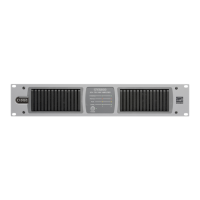CA / CV Series Module Replacement
Models affected: CV2500, CV4250, CV8125, CA2250, CA2500, CA4250, CA6160, CA8125
Explanation: Procedure for diagnosing and replacing Amplifier and PSU modules
Revision history:
V1.0
Initial Revision
Introduction
This technical bulletin explains the procedure for diagnosing a fault with an amplifier channel module or PSU,
in both the CV and CA series amplifiers. It is recommended to read the information in this introductory section
before attempting diagnosis of fault conditions, because it provides key background information as to why
certain faults present in certain ways.
Both series of amplifiers utilise the same PSU and amplifier modules, and integrate them in a similar way. With
the exception of the CA2250, all models utilise 2 PSU modules, and therefore feature two separate groups of
channels, referred to as the “odd” (1, 3, 5, 7) and “even” (2, 4, 6, 8) channel groups. The CA2250 model is
unique, in that it features a single PSU module, and therefore a single unified group of odd and even channels.
Due to the way in which the amplifier modules in the odd and even channel groupings share a PSU, if the
amplifier control logic determines that it is necessary to “wake” one or more of the amplifier channels on a
PSU, all of the amplifier channels on that PSU must be simultaneously brought out of standby and given
power. This is a fundamental requirement of the CA and CV design, and has consequences for the behaviour of
the amplifier under different types of fault condition.
The amplifier fault conditions can be categorised into two separate types:
• Fault conditions affecting a single channel in isolation, without requiring additional intervention from
a PSU module.
Typically, these are transient and recoverable, e.g. over-temperature, a speaker load which is too high
for the channel, or a short-circuit on the speaker line. Self-recovery will usually occur as soon as the
module has cooled, the load is corrected, or the short-circuit is removed. No further action is typically
necessary for this kind of fault.
Fault conditions which do not require intervention from a PSU module, will only illuminate the
“protect” LED for the amplifier channel that has the fault, allowing for easy identification of the
primary issue.
It is also possible for a single amplifier module to fail in a way which is permanent and non-
recoverable. This requires the replacement of the specific amplifier module identified by the channel
protect LED.

